
Tim Burton’s The Nightmare Before Christmas was released under the Touchstone label in 1993 because the studio felt that the film might be too intense for younger viewers, and it was certainly out of the box compared to a traditional Disney animated film. Yet, more than twenty-five years on, the film has survived, thrived, and become a bona fide holiday classic. “That’s because the generation has now grown up. Moms did not want their children to watch it. Those children who watched it are now moms raising their children on it,” said Thomas Schumacher, the animation executive who oversaw Nightmare when it was made. He remembered that the idea of a Halloween Town resident walking around with an ax stuck in his head was so offensive to people back then. Today, the mostly-silent character, referred to now as Behemoth, is just one of the iconic images that signals Nightmare to its fans.

Like a plane lifting off the runway, Nightmare eventually soared to the heavens, going from cult status to a mainstream holiday classic and merchandising juggernaut. The merchandise for Nightmare has been a meteoric success. There is a store in the New Orleans Square area of Disneyland with devoted space to Nightmare merchandise that’s paired with Haunted Mansion merchandise. Some retail stores stock up on as much Nightmare-themed products as they can during the Halloween and Christmas seasons because it sells well every year. Fans have sported Nightmare-themed body tattoos, and others have named their children after the characters in the film.
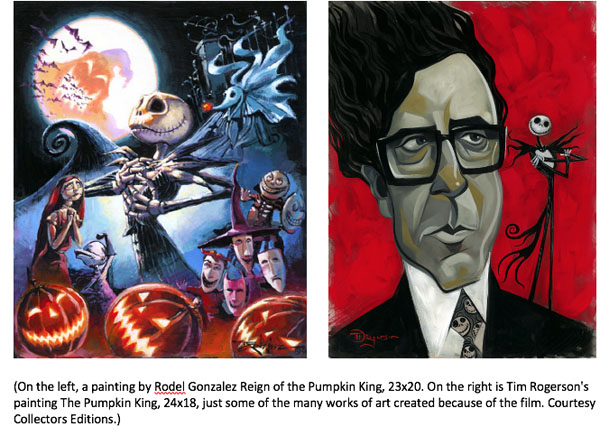
In 2001, the Haunted Mansion at Disneyland first got its annual, seasonal makeover blending the characters and world of Nightmare with the beloved attraction. “I sure love it,” said Henry Selick. “I mean, when Disneyland first turned out Haunted Mansion Holiday, they did a great job. I was really impressed. They captured Jack. It had taken them a long time, but they’d figured out what they have, and then they knew how to merchandise it, but really they captured what was there and honored it.” In a sense, by being part of an attraction layover, Nightmare rose from a small film to being officially welcomed into the Disney family. It connected with the Disney audience on a much larger scale. “[With] this connection, we did something that lived. We did something that people still like, that other generations are discovering,” said Selick. “That kids are still dressing up as characters from it for Halloween. It’s, you know? It’s big; it’s outside of us. It has its own life.” The film has become a holiday staple that continues to grow in popularity, perme¬ating pop culture.
In 2006, the film was re-released under the Walt Disney Pictures moniker. “I always think that Nightmare gives audiences permission to recognize and spend a little mischievous time having fun on the dark side of everyone’s collective childhood versions of Halloween and Christmas, the two holidays I would wager are most people’s favorites,” said Assistant Art Director Kelly Asbury.
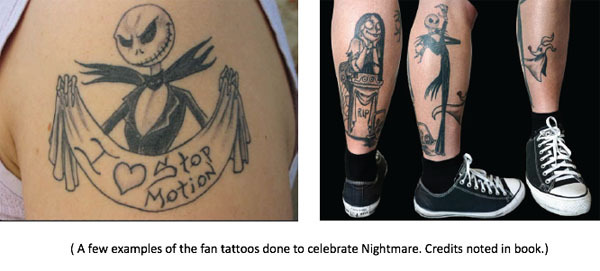
The film has resonated around the world because, as Selick observed, “There’s always way more oddball kids than you realize.” That may be one of the reasons that so many flock to see Burton’s traveling art exhibition that has been crisscrossing the world since 2009. It includes some of Burton’s own concept art from Nightmare along with some of the film’s original puppets. “Tim’s touring art exhibit provides an opportunity for him to connect with fans at various events and book signings,” explains Derek Frey, who runs Tim Burton Productions and has attended a majority of the fourteen art exhibit openings. “He gets to meet a lot of the fan base that’s out there around the world. Consistently, Nightmare is the film that’s the most represented in terms of people showing up in character costumes or wearing Nightmare attire. Many fans feel a deep connection with this work and will give Tim gifts they have handcrafted. Very often, those gifts represent Nightmare or the characters that occupy that world. A lot of people like to have Tim sign their body parts so they can get that tattooed, often above or below a Nightmare tattoo.” Some of the tattoos are small, simple line drawings of Jack’s head or one of the other principals to full color “sleeves” of multiple characters or representations of a specific scene in the film. It’s a permanent expression of adoration for the film by the uber-fans.
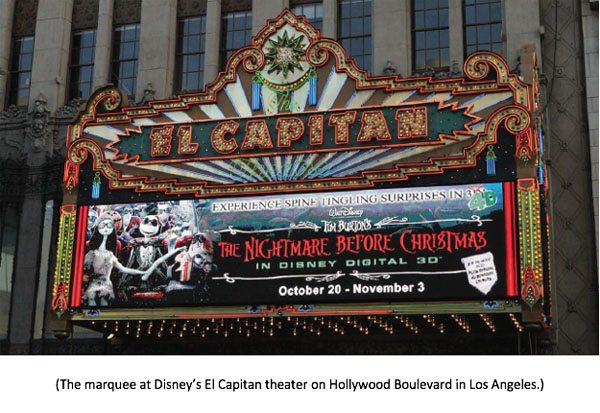
The film continued to resonate and built a “cult” following in the early years after its initial release, but is now considered a holiday classic. The Nightmare storybook continues to be rereleased in different formats, selling strongly on an annual basis. As the popularity of the film con¬tinued to build, more merchandise was designed and released, which accelerated the robust sales. This has led to Halloween rereleases of Nightmare, the conversion of the film into a 3-D version, and even live concerts featuring the songs and soundtrack of the movie.
At annual Halloween screenings of Nightmare, much like the exhibits, audience members often show up dressed as their favorite charac¬ter from the film or wearing any number of Nightmare-themed apparel ranging from legitimate costumed role-playing (affectingly known as cosplay) to everyday clothing with styles, colors, and accessories that pay homage to a particular character or theme. “For years, I hosted the special Halloween screenings of Nightmare at the El Capitan Theatre in Hollywood,” said Don Hahn, legendary producer of Beauty and the Beast, The Lion King, and many other films. The theater holds about 1,100 people, and each year it would be packed with families that made it a Halloween tradition.

“After a while, we started doing costume contests; we brought the Dapper Dans of Disneyland out to sing ‘“Grim Grinning Ghosts,’” says Hahn, “And one year, in one of the most cheesy, yet crowd-pleasing mo¬ments of my career, we rigged a candelabra with fishing wire and flew it out over the stage to the collective cheers of the audience.” Each year’s screening would include special guests with Director Henry Selick, Danny Elfman, and many others making appearances. “For many years Tim actually created a small surprise video greeting for the El Cap guests,” said Kevin Frawley, vice president of special events. “There were years that the El Cap showed Nightmare in conjunction with either Burton’s original Frankenweenie or Vincent.”
“Tim [Burton] would always make an on-screen appearance with a special greeting projected on the large screen for the audience at the El Capitan,” said Hahn. “The most memorable being the year he did the whole greeting while wearing a Mexican wrestler luchador mask. The topper was Nightmare Before Christmas in 4-D.”
The film itself was not created in 3-D, but Industrial Light & Magic (ILM) converted the film to what was called Disney Digital 3-D in 2006. Burton worked closely with them to oversee the process, taking great care to ensure the conversion was impactful without being overdone. For the 4-D presentation, Hahn “introduced live effects into the theater: snowflakes, lightning flashes, fog, and even a fresh pine scent when the film went to Christmas Town. The whole Nightmare at the El Capitan experience was and is a tradition without equal in entertainment.”
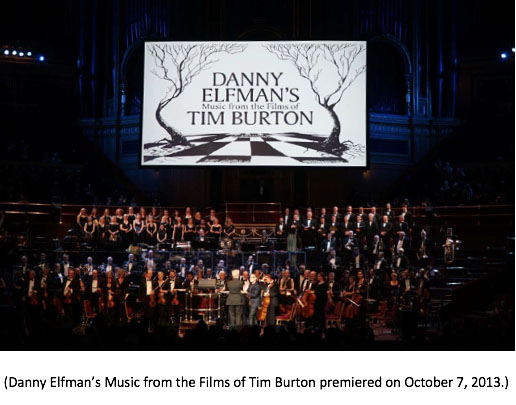
The live concert concept came about as an offshoot of Danny Elfman’s Music from the Films of Tim Burton, which contained music pieces from all the movies they had collaborated on. At the world premiere of the concert at the Royal Albert Hall in London, Elfman sang live as Jack Skellington for the first time ever. In fact, Elfman had not performed live in nearly eighteen years. “And Danny, who used to be a rock star with Oingo Boingo, was like coming out of mothballs as a singer and completely knocked it out of the ballpark in London,” said the show’s producer and creative director, Richard Kraft.
Elfman took the concert to Japan—and afterward, the suggestion was made to do all of Nightmare live in concert. The concert was test-marketed in Japan first and did very well, according to Kraft. “And so, Danny said, ‘Why don’t we bring this to America.’” The show sold out instantly at the Hollywood Bowl, and they added a second night, which also sold out. The concept resonated with audiences and turned out to be an unforgettable night at the Hollywood venue.
There were two reasons why doing the concerts made sense. One, Nightmare is now an iconic holiday classic. The film has a broad following of fans that love both the movie and the soundtrack. And two, Oingo Boingo had a tradition of doing Halloween concerts in the Los Angeles area every year. The band did them from 1980 through 1995. The final farewell concert for the band was on Halloween night in 1995 in Los Angeles. So, having Elfman performing and singing live on stage again at the classic Halloween icon was exciting and tapped into an entirely different fan base as well. “So, bringing it back to L.A. with the film, the songs, the music, and Danny Elfman performing and singing live on stage on Halloween in Los Angeles all was the perfect scenario,” said Show Producer Laura Engel.
And in addition to Elfman singing Jack live, he also did the voice of Barrel. There was a cast of four performers doing six characters and singing their parts. The main character voices, the movie’s original stars, came onstage at the concert to sing their parts. Catherine O’Hara reprised her roles as Sally and Shock, while Ken Page was once again Oogie Boogie, and Paul Reubens performed as Lock.
To make the show more of a concert experience rather than just a live performance of music to the movie, the team added a seven-minute overture to the beginning of the concert. The music, composed by Elfman, is performed by a live orchestra to a montage of Burton’s original development drawings and sketches for Nightmare. “The drawings Tim [Burton] did during the development of the movie are gorgeous,” said Kraft. The concert was broken into two acts—and an intermission was added. At the beginning of the second act, the audience is treated to a musical interlude, a fantasy of themes from The Nightmare Before Christmas, by gifted violinist Sandy Cameron. Elfman liked her performance so much that he has written a violin concerto for her.

Engel observed, “The Nightmare Before Christmas is iconic. . . it’s tran¬scended from a cult classic to become a genuine holiday classic.” That was evidenced by the three sold-out Hollywood Bowl shows in 2016. The concerts were conducted by John Mauceri and produced in association with and licensed by Disney Concerts.
The concerts have brought a completely new experience to this now holiday classic. Parents who saw the film as kids are now bringing their children to see the film. And at the live concerts, many are dressing up as their favorite Nightmare characters. The film has become an authentic family experience in every sense.
One of the common threads that surfaced as crew members looked back a quarter of a century since making Nightmare is the intimate group of artists that made the film. “Nightmare had a purity to it that doesn’t exist anymore. Or doesn’t appear to. And, I kind of miss that simplicity,” said Animator Trey Thomas. The film has stood the test of time, which is the real measure of a classic—just how it resonates so many years later. “I watch this movie, and I’m amazed how well it stands up,” said Co-producer Kathleen Gavin. “It was unbelievable how well it stood up. I was surprised by that, and that’s the truth of it. It stands up because it’s a sincere, lovely movie.”
At the onset, Nightmare was considered an opportunity for Disney to work with Tim Burton, and yet, allowing a group of filmmakers, artists, technicians, and craftspeople to make a film in a warehouse in San Francisco without much oversight from studio executives may have been a critical recipe ingredient for how this film has become an endearing classic. “Indie, outlaw kind of,” described Assistant Art Director Kendal Cronkhite. “And we had a sense that it was something special. We didn’t know. But you had a sense that it was. And just creatively free. We were kind of creatively left alone.”
The process allowed for the film to be crafted as a piece of art—a visual masterpiece that blends the genius of Burton’s simple story and his unique design aesthetic with Danny Elfman’s eclectic songs and score and Henry Selick’s stop-motion brilliance. The delight of that artwork and its resonance is a huge driving factor for the movie’s popularity. The film’s art direction is so powerful and creates a world that audiences want to revisit repeatedly. The fact that Sally is all stitched together or she’ll fall apart is such a profound metaphor. And Jack ultimately realizes that it’s okay to be himself and that the grass is not always greener on the other side. “You can’t keep a wildly creative man down,” said Selick. “You can’t keep [down] someone whose enthusiasm is as great as Jack’s—it’s going to rekindle itself. He needed to go to the other side to appreciate what he is and what he has.”
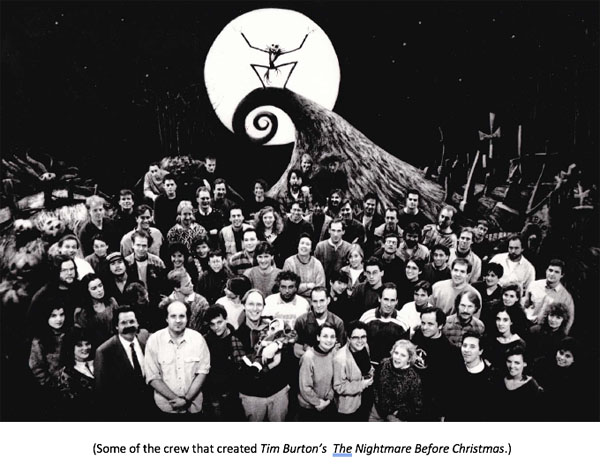
Put all those elements together, and it speaks to why people are drawn to it and why the film resonates emotionally. It has that feeling that Burton mentions in describing what stop-motion does for him and so many artists who worked on the film. “That’s why you love Frankenstein [1931] or Pinocchio [1940]. All these stories about inanimate objects coming to life,” said Burton. “And I remember, again, as children you experiment with stop-motion. And that idea one frame at a time—and then you see it move. It gives you tactile energy, and it’s something that is different from drawing or punching a keyboard. You know, it’s just a different medium that’s quite exciting.”
Since completing The Nightmare Before Christmas, Burton has had many more successes on a multitude of films. But he has periodically gravitated back to stop-motion doing Corpse Bride in 2005 and then Frankenweenie in 2012, based on his 1984 black-and-white, live-action short film. When asked if he would do another stop-motion film, Burton responded. “I would like to — yes. Because I love it.”
Text ©2021 David A. Bossert
Portions of this article have been extracted from the author’s book, “Tim Burton’s The Nightmare Before Christmas Visual Companion”. All footnotes attributions are noted in the book. This book is currently sitting with Disney Editions Publishing with no release date announced.


 David A. Bossert is an award-winning artist, filmmaker, and author. He received his B.A. from CalArts School of Film and Video with a major in Character Animation. As a 32-year veteran of The Walt Disney Company, he contributed his talents to The Black Cauldron (1985), Who Framed Roger Rabbit (1988), The Little Mermaid (1989), Beauty and the Beast (1991), Aladdin (1992), Tim Burton’s The Nightmare Before Christmas (1993), The Lion King (1995), Fantasia/2000 (1999), and the Academy Award-nominated shorts Runaway Brain (1995), Dali/Disney Destino (2003), and Lorenzo (2004), among many others. Bossert is now an independent producer, creative director, and writer.
David A. Bossert is an award-winning artist, filmmaker, and author. He received his B.A. from CalArts School of Film and Video with a major in Character Animation. As a 32-year veteran of The Walt Disney Company, he contributed his talents to The Black Cauldron (1985), Who Framed Roger Rabbit (1988), The Little Mermaid (1989), Beauty and the Beast (1991), Aladdin (1992), Tim Burton’s The Nightmare Before Christmas (1993), The Lion King (1995), Fantasia/2000 (1999), and the Academy Award-nominated shorts Runaway Brain (1995), Dali/Disney Destino (2003), and Lorenzo (2004), among many others. Bossert is now an independent producer, creative director, and writer.













































































Nightmare Before Christmas is unique on many levels. In the first place, it’s brilliant for marketing because it capitalizes on Hallowe’en and Christmas at the same time. Secondly, when I first saw it in theatres I was immediately reminded of the old Rankin/Bass Christmas specials as well as their films of Mad Monster Party and Mad, Mad Monsters. Later Tim Burton mentioned that he was strongly influenced by Rankin/Bass. Thirdly, this film stands out among the Disney output as one of the few operettas with a mainstream following–and script-wise, musically, Nightmare is purely an operetta. This art form is not frequently done by Disney. (I would classify Beauty and the Beast as an operetta, as well.) But as an art form, operetta does not always reach a wide audience in our times. It’s refreshing to see that in this instance, the form still has viability for modern audiences.
Hello Dave,
Well I hope Disney publishes it!
I remember walking through San Francisco’s Union Square just after it was released and seeing the original(?) models in a department store window display. I never did ask Henry Selick about that. If this was true I hope you might consider including it in the book.
Back then, no one really stopped to take a good look. Today, the windows would be smashed and all the models would be stolen!
Yes, it seems that they were the original models! I found this Macy’s ad on Newspapers.com: https://www.newspapers.com/clip/88658161/ad-for-a-macys-the-nightmare-before-ch/
What a magical movie! Not since Charlie Brown and Rankin-Bass were holidays so honored. Last Saturday was the 28th anniversary of its initial pre-release screening for Disney employees (I was the guest of one, whom I later had the good sense to marry) at the El Capitan Theater in Hollywood. It certainly holds up on its own; the so-called 4D effects are largely unnecessary.
I keep hoping for a sequel of sorts which takes us through all those other doors “where holidays come from.”
The Easter Bunny invades St. Patrickstown?
Well, may be a hard sell.
My parents were pretty open-minded about what I could watch/read and I remember watching this feature over and over again on VHS. As a teenager I bought anything from Hot Topic related to the feature. At that time it was still very much a film for outsiders (at least where I grew up in Pennsylvania). But I am glad to see it has entered the mainstream over the years and continues to thrive!